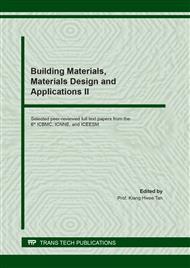p.87
p.99
p.111
p.119
p.129
p.141
p.149
p.157
p.165
Provisions of Sustainability in Structural Design Approaches in Different Codes
Abstract:
Concrete has changed the norms in the Construction industry, it has modified the thinking and possibilities of the general public. Particularly, Reinforced Cement Concrete (RCC) is being used throughout the world; whether it be tall sky scrapers in the Middle East, or the vast buildings in Central Europe, RCC has altered the construction Industry. But then again, RCC has its fair share of shortcomings, in recent times it has been recorded that RCC structures collapse due to brittle failure. Seismic loading, mainly from earthquakes are mostly responsible for structure failure as seismic waves generally lead towards overloading and ultimately the structure fails. Cement is generally an energy releasing material and it releases immense amount of CO2 emissions into the earth’s atmosphere, causing the ozone layer to deplete. Hence to minimize this impact and to provide a sustainable solution and to minimize the accidents different sustainable houses are being provided to the people. By doing this, we can reuse existing building assets to minimize the waste and to reduce the pollution. In 2011, International Organization launched the Life cycle Sustainability assessment to have a more sustainable approach towards construction by using different techniques. Life cycle sustainability assessment is a suitable too used for environmental performance of buildings. In this paper we will look to observe different provisions of sustainability in different structural designs taking different codes as a reference.
Info:
Periodical:
Pages:
149-155
Citation:
Online since:
August 2021
Authors:
Price:
Сopyright:
© 2021 Trans Tech Publications Ltd. All Rights Reserved
Share:
Citation:



